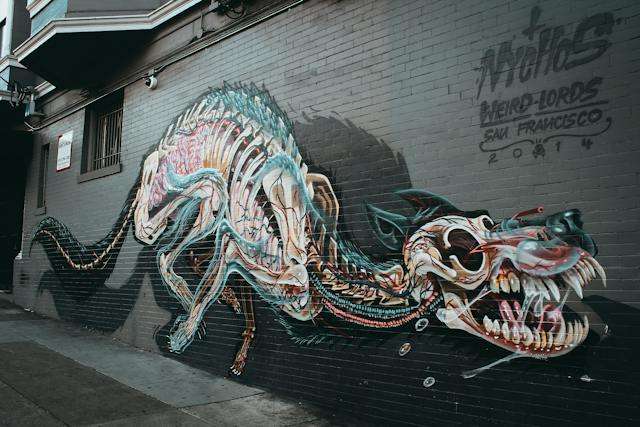The Vibrant World of Graffiti and Street Art

Step into the colorful and vibrant world of graffiti and street art, where urban landscapes are transformed into open-air art galleries. From political statements to beautiful murals, the art form of graffiti and street art has evolved and captivated people around the globe. Let’s explore the artistic expressions, the controversy, and the impact of this intriguing art movement.

History of Graffiti and Street Art
Step back in time and explore the colorful evolution of urban art. From its humble beginnings to its current cultural impact, the history of this art form is a captivating journey through the streets. Let’s delve into the origin, the pioneers, and the movements that have shaped this vibrant artistic expression.
Origin and Early Developments
Graffiti and street art have a rich history that dates back to ancient times. The earliest forms of public expression can be traced to ancient civilizations like the Egyptians, Greeks, and Romans, who left their marks on walls and buildings. Fast forward to the 20th century, and the modern-day graffiti movement began in the streets of Philadelphia and New York City, where artists used subway cars and building facades as their canvas, giving birth to a new form of artistic expression that now spans the globe. This early period laid the foundation for the vibrant and diverse art form that we know today.
Key Figures and Movements
When it comes to the pioneers and influencers in the world of graffiti and street art, names like Jean-Michel Basquiat and Keith Haring instantly come to mind. These artists broke new ground in the 1980s, using the streets as their canvas and their artwork as a means of self-expression and social commentary. Their movements paved the way for a new generation of artists to contribute to the urban art scene, inspiring creativity and pushing boundaries. The influential movements of graffiti and street art continue to evolve, with artists like Banksy and Shepard Fairey carving out their own space in this vibrant art form.
Artistic Techniques and Styles
Step into the world of artistic techniques and styles within this vibrant art form. From the spontaneity of spray painting to the precision of stencil art, graffiti and street art manifest in various captivating forms. The boldness of muralism and the allure of wheatpaste posters further enrich the urban landscape, offering an array of artistic expressions that capture the essence of the streets.
Spray Painting and Stencil Art
In the world of street art, spray painting and stencil art are two popular and impactful techniques. Artists use aerosol cans to create bold, vivid images that cover large surfaces, adding a burst of color to urban landscapes. Stencil art, on the other hand, involves the use of pre-cut designs to create repetitive patterns or detailed images with layers of paint, adding a unique and dynamic element to the art form. These techniques allow artists to swiftly and boldly express their creativity, leaving a vibrant mark on the city streets.
Muralism and Wheatpaste Posters
Muralism is the art of creating large-scale paintings or artwork on walls and surfaces, often in public spaces, to make a bold statement or showcase a visual narrative. These murals can be thought-provoking, culturally significant, or just aesthetically pleasing. On the other hand, wheatpaste posters involve an adhesive mixture of wheat flour or starch and water to paste posters onto outdoor surfaces. Artists then use this technique to create eye-catching, temporary displays that can convey social commentary, advertise events, or simply add color and vibrancy to urban settings. Both of these artistic approaches contribute to the rich tapestry of street art and add depth and character to our urban environments.
Artists use the scale of buildings and structures to create larger-than-life visual experiences that engage and captivate viewers, breathing new life into overlooked or neglected spaces. While some murals serve as aesthetic additions to neighborhoods, others address social or political issues, making powerful statements that resonate with the community. Wheatpaste posters similarly add a touch of whimsy and surprise, often shifting how passersby perceive the world around them.
Social Impact and Controversy
Step into the world of street art, and you’ll find more than just vibrant murals and skillful designs. Street art serves as a platform for social commentary and activism, addressing issues that resonate with communities around the world. From advocating for human rights to challenging societal norms, street art acts as a visual voice for the voiceless and the marginalized. It’s not just about the art; it’s about the impact and the conversations it sparks.
Street Art as Protest and Advocacy
Street art has become a powerful tool for protest and advocacy, allowing artists to communicate bold messages in public spaces. Through vibrant murals and striking images, this art form has been used to shed light on social and political issues, sparking important conversations and challenging the status quo. By leveraging the visibility of urban environments, street artists drive attention to causes and injustices that might otherwise go unnoticed, amplifying voices and advocating for change. It’s a raw and unapologetic form of expression that demands attention and ignites thought-provoking discussions.
Legal and Ethical Considerations
When it comes to legal and ethical considerations in the world of graffiti and street art, there’s a complex interplay of perspectives. Some argue that these art forms are illegal and contribute to visual pollution, while others advocate for their cultural and artistic value. Artists often grapple with questions of where it’s appropriate to create and display their work, navigating the fine line between creative expression and respect for public and private property. Finding a balance between artistic freedom and respect for the law remains an ongoing conversation in the dynamic world of street art.
Conclusion
Graffiti and street art transcend boundaries, challenging conventions and inviting conversation. As these art forms continue to evolve, they serve as powerful expressions of creativity and social consciousness, leaving a lasting impression on the urban landscape and the minds of those who encounter them.

